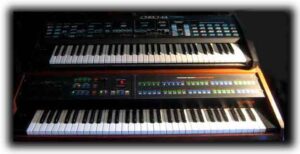 Interview with Paul de Benedictis – As told to Linda Jacobson
Interview with Paul de Benedictis – As told to Linda Jacobson
LJ: Paul, what were you doing in 1984 — the year before you became a founding staff member of Opcode Systems? How would you describe the “work lifestyle,” routine, and group dynamic behind-the-scenes in your world then? Was the SF Bay Area audio industry back then influenced more by the cultures of the computer industry and Silicon Valley, music industry, San Francisco scene, and/or film industry and Hollywood?
PdB: In 1982 I had purchased a Rhodes Chroma synth and in 1983 created one of the first computer-based electronic music “home” studios in the San Francisco Bay Area around that instrument. I had added the Apple II computer and the sequencing and editing software from Fender along with the SIMPLE System synchronizer for video and audio and the requisite mixers, mics, speakers, 2-channel and multitrack tape decks. I was composing music for film and television and through my friend Doug McKechnie’s connection at Lucas Film I even had a chance to write a demo cue for the final Ewok scene in the latest Star Wars: Return of the Jedi movie, apparently Lucas wanted to hear some other ideas than what John Williams had come up with. Three of us in the San Francisco Synthesizer Ensemble got to write a sketch for the cue. It was exciting to see part of the movie before it came out. [Full Interview HERE ]
People were coming to me with their original music as well and I was helping them realize it on synths with the sequencer. They wanted more control and more editing. One project was the complete score to a Traveling Jewish Theater piece that was brilliant. I still had a day job and was trying to make a dent in the local film and TV scoring scene.
My Emu Drumulator had a JL Cooper mod for 3 optional chip sets which I got from Peter Gotcher and Evan Brooks at DigiDrums —later to become Digidesign. I became friends with them both and used to call Peter at Dolby where he had his day job. Evan used to program custom snare chips for me. It was a very small industry at that point.
When I first saw the Macintosh computer at Macy’s in San Francisco they demoed “MacPaint” and I immediately tried to find the “music software” for it, but there wasn’t anything available. A local Macintosh specialty shop called “Mac Studio” – nothing to do with music though- hired me to find the music software for Mac after I showed the manager my computer music studio with the Chroma and Apple II.
Full Interview HERE







